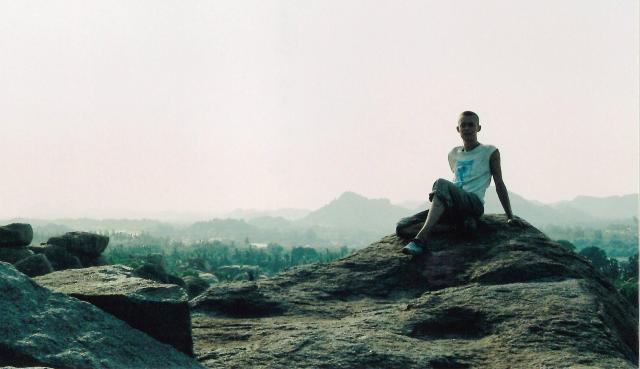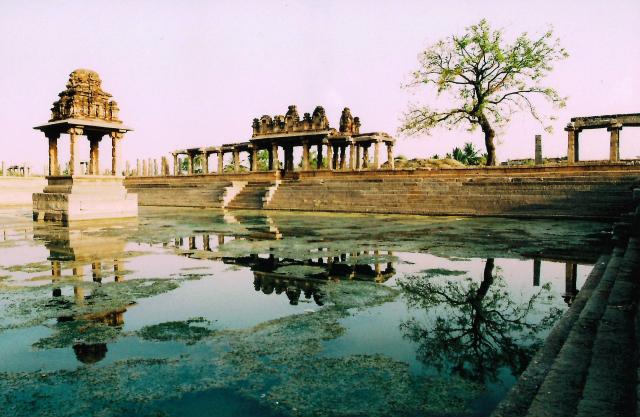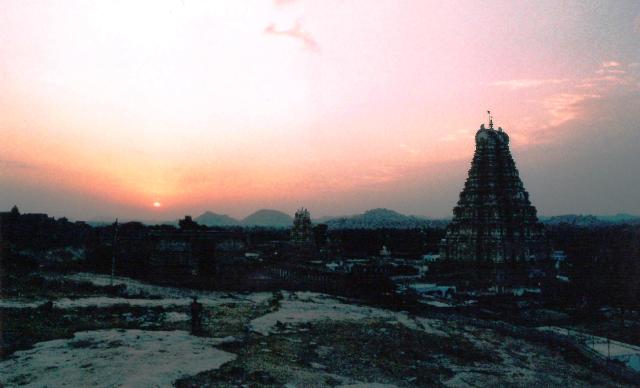It was a strange sensation to have awoken from a dream about my home and my family, to realise that I was gliding smoothly sideways across a strange, rocky landscape in central India. As I shuffled out of my carriage and through the sliding door that we had walked through last night, the clatter of the train, the stench of the toilet and the heat of the morning hit me once more. This change dispelled all doubt: I was not back in south west England.
But where actually was I? The landscape we rattled over reminded me more of Nevada than Karnataka, such were the hot and scrubby vallies that stretched up into red-brown rock formations reminiscent of the Road Runner Disney cartoons. Though not quite hills, these rocky stacks were deep in colour against the white-ish blue of the sky. Out and across this landscape, I saw almost no evidence of human settlement to speak of, other than the occasional two-story railway point-cabins and the tracks that twisted and danced beneath me.
In time, we arrived at the small but bustling town of Hospet, from which we took a bus through the choking dust and ever-yellowing landscape to Hampi, our final destination. Hampi is one of the most visited places in south India. The reason for this is the stunning blend of human culture and the natural environment that it sits amongst. This combination seems to be what India is particularly good at offering to visitors.
As we drew closer to the town, the landscape took on an increasingly distinctive form until we found ourselves encircled by amazing scenery as we reached the town itself.
Through some geological freak circumstance, the rolling sandy-coloured landscape around us was littered with round boulders that appeared to have been dropped into enormous piles by some kind of crane from the heavens. Some were only the size of the rucksack that I carried on my back, while others were the size of large houses, all tumbling over one another and scattered across the landscape in the chaotic stacks around us. It appeared like a heavenly deity had gingerly perched them into piles here and there for collection later and then hurriedly disappeared with their work half-finished, leaving human-kind to seep into the area and settle into existence amongst the divine rubble. Ruins of temples stood here and there, paths weaved apologetically around boulders, scattered heards of goats picked their way across the dust and, across the flatter land, splashes of richly-coloured palm forests grew like a green sea amongst the jagged rocks at a water’s edge.
In a wide panorama beyond the chaotic rock-scape in front of us, the skyline that stretched against the haze wiggled and bumped up and down like a jittery hand had sketched it out against the hot, grey sky. Indeed, it almost appeared that the piles that peaked up across the horizon around us could be topped with a hearty push until you reached the foot of the mounds and realised just how large the rocks that made them were. How on earth did they get here? How have they been weathered and eroded to such uniformly-smooth, rounded shapes? How, if they have been subject to erosion, have they not clattered to the ground and smoothed out the landscape to a flatter, dusty environment that the rest of the region appeared to be?
As with any natural environment, the best way to attempt to solve these mysteries was to walk amongst the rocks and feel their warmth in the evening light, listen to the way the sound echoes around the strange formations and watch as the small gaggles of children chased each other up and down the twisting paths.
I walked alone that evening through the lengthening shadows. Alec and I had wandered apart and I periodically saw the recognisable white of his t-shirt and the brown of his hat dotted against the occasional rocky backdrop or, further away and some time later, perched atop of a boulder a mile away. We would likely drift back to the hotel as night fell.
In the meantime, I found myself periodically stumbling across the collection of ruins that seemed to be scattered across the area like the rocks that surrounded them: A small, run down shrine in a chapel of some kind that overlooked a hazy panorama; Further over the hill, a wide walkway stretched out from one end of a small valley to the other, like a grand promenade linking one temple to a smaller one at the other end, half-collapsed and neglected.

It was easy to feel like you were the one to re-discover many of these ruins yourself.
-Hampi, India-
From time to time there were sunk into the ground large, shallow square or rectangular pools of water lined with steps down to the water’s edge and surrounded by neat pathways and awnings. Some of these were small and un-ceremonial, tucked away beneath ruined temples, forgotten and half-full of detritus and sticks. Others, however, were spectacularly-sized and clearly devised with aesthetics in mind, so that the still-intact architecture that proudly stood around them reflected off the water in a vivid image of symmetry and beauty. Whether these had been for bathing, ornamental purposes or even (god forbid) for drinking water, I did not know. Now, it seemed that they were merely ornamental, as the water itself was invariably green, stagnant and full of algae. But they were also still, peaceful and serene in the quiet, warm air of the early evening.
Sure enough, Alec was back at the hotel when I got home that night, stretched out on a hammock that hung in the courtyard of our tremendously-coloured hotel just off the main street. The courtyard stretched two stories up, while around us, low bushes grew in a small plot in the centre of the courtyard. Echoes floated in from the rooms around us and off the alleyway next to us.
During the darkness of a power cut, we produced the squished boxes of cheap anti-malarial medication from the bottom of our rucksacks. We had hastily purchased them online only days before we had boarded our flights and, as we headed further north, we had been putting off our course of drugs that we had been told were so necessary, knowing that they could yield unpleasant side-effects in some cases. However, as we entered India’s medium-risk malarial zone, the time had come. Dividing up the various pills that we needed to take at differing intervals for the next few weeks, we crammed a handful of white, bitter pills into our mouths in the darkness. For just a moment, I had a fleeting image of a pile of enormous rocks in my hand that I was about to scatter across a strange, dusty landscape like dice on a stone floor.
***





